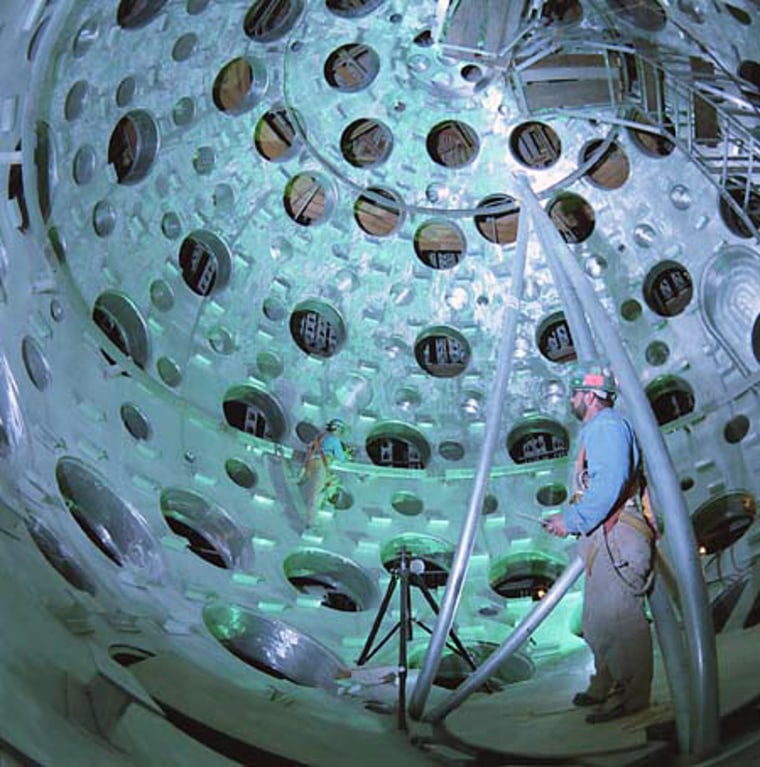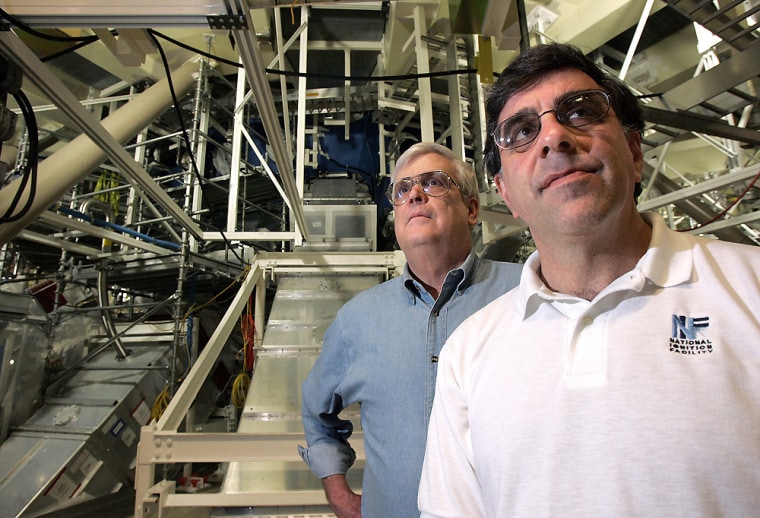Ed Moses talks of the “grand challenge” that has consumed him for the past five years, comparing it to trying to hit the strike zone with a baseball from 350 miles away or tossing a dime into a parking meter from 40 miles.
“That’s the precision we have to have,” says Moses, the director of a high-energy physics adventure to produce the world’s most powerful laser — one that scientists hope will create in a laboratory the energy found at the center of the sun.
In a building the size of a football stadium, engineers have assembled the framework for a network of 192 laser beams, each traveling 1,000 feet (300 meters) to converge simultaneously on a target the size of a pencil eraser.
The trip will take one-thousandth of a second, during which the light’s energy is amplified many billions of times to create a brief laser pulse 1,000 times the electric generating power of the United States.
The goal is to create unimaginable heat — 180 million degrees Fahrenheit (82 million degrees Celsius) — and intense pressure from all directions on a BB-size hydrogen fuel pellet, compressing it to one-thirtieth of its size.
The result, the scientists hope, will be a fusing of atoms so that more energy is released than is generated by the laser beams, something scientists call fusion ignition. It is what happens when a hydrogen bomb explodes.
The 'Hubble' of lasers
Four of the beams have been tested. When completed in 2008, the National Ignition Facility, or NIF as the laser at the Lawrence Livermore National Laboratories is called, will dwarf many times over any laser to date.
It will provide a platform for many experiments in high-energy and high-density physics, from learning more about the planets and stars to advancing the elusive hunt for fusion energy to generate electric power, Moses says.
“You have to think of this like the Hubble,” he says, referring to the space telescope. “It’s a place where you will see things and do things that you couldn’t do anywhere else.”
But the federal government is investing $3.5 billion, and possibly several billion dollars more, in NIF for another reason: national security.
If NIF achieves fusion ignition, it will for the first time in a laboratory simulate the pressures and heat of a nuclear explosion, allowing nuclear weapons scientists to study the performance and readiness of the country’s aging nuclear arsenal without actually detonating a nuclear device.
Underground nuclear testing in the Nevada desert ended in 1992.
The NIF laser “is essential to assessing the potential performance of nuclear weapons,” says Energy Secretary Samuel Bodman. He says the experiments will help determine the effects of aging on warheads and help assure they will work as expected, should they be needed.
Fusion is fundamental
There have been other lasers, including a 10-beam Livermore project called Nova. NIF will produce 40 to 60 times more energy. “It’s the difference between a car and a jet engine,” Moses says.
For many supporters the “pass-fail” is whether the NIF lasers will achieve fusion ignition.
“We never intended to spend $5 billion to $6 billion to build a laser facility for ... civilian research,” Sen. Pete Domenici, R-N.M., chairman of the Senate subcommittee that funds the NIF program, lectured an Energy Department scientist last year when he learned fusion ignition experiments might be postponed.
Energy Department officials now say the project remains on schedule with the first fusion ignition tests planned for 2010. Domenici remains skeptical.
“It’s a terrible expense and a drain” on other programs to maintain the nuclear arsenal, Domenici said in an interview. “They’re going to have to prove they can get the job done.”
Among some people, fusion ignition “has become the poster child for NIF being successful” and that shouldn’t be the case, counters George Miller, a former nuclear weapons designer and bomb tester who heads the project. He says there are many other experiments for which NIF will be valuable to nuclear weapons scientists.
“We are conscious of the importance of ignition” and “there’s no reason to think we’re not going to get it,” Linton Brooks, head of the federal National Nuclear Security Administration that oversees the country’s nuclear weapons arsenal, said in an interview.
But at a recent Senate hearing, Brooks said a 14 percent budget cutback in the fusion ignition program creates “additional risks” that fusion ignition may not be achieved in the 2010 timeframe.
A decade of turbulent history
The NIF program has had a decade of turbulent history marked by exhilarating successes and embarrassing setbacks, large cost overruns and charges by some critics that the project was oversold from the beginning to win initial support in Congress.
When the idea of a new, super laser first emerged in the early 1990s, the cost was put at less than $700 million. By the time construction began in 1997, the price had grown to $2.1 billion with completion by 2004; three years later it ballooned to $3.3 billion and the completion date delayed four years. Critics contend the price is now up to $5 billion when associated expenses such as developing a target capsule capable of achieving fusion ignition are included.
“If Congress knew it would cost $5 billion up front, would they ever have funded it? No way,” maintains Christopher Paine, who has monitored NIF’s development for the Natural Resources Defense Council, an environment advocacy group, and has been one of its sharpest critics.
Despite its price escalation and remaining uncertainties, NIF maintains strong support in both Congress and the Bush administration. However, there have been other high-energy physics projects on which billions of dollars have been spent only to be dumped.
Congress pulled the plug in 1993 on the Superconducting Super Collider project, a racetrack-like device in Texas to study elementary particles and forces, after spending $2 billion. The Clinch River Breeder Reactor project in Tennessee was canceled a decade earlier after $1.7 billion had been spent as the United States abandoned nuclear fuel reprocessing. Both projects had large cost overruns.
‘Unlovable laser’?
Paine, who in a critique once dubbed NIF “The Unlovable Laser,” maintains that NIF should follow the same path.

He says it isn’t needed and poses a nuclear proliferation risk because it might make it easier in decades ahead to develop new nuclear weapons, not just maintain existing ones.
The JASONs, a group of scientists frequently called upon to review complex defense or national security issues, has concluded that NIF “does not represent a significant proliferation risk” and is “fully compatible” with U.S. nonproliferation goals.
Still, a recent report by the Defense Science Board, which advises the Pentagon, urged more openness about NIF activities and a mix of civilian and defense NIF experiments to ease any public concerns about the laser’s purpose.
The question of openness has been an issue before.
The program’s critics charge that Livermore officials lowballed NIF’s capabilities and potential cost from the beginning. When Congress was sold on NIF’s importance because of its ability to simulate a nuclear explosion, scientists were at best only half certain fusion ignition could be accomplished, NIF program supporters acknowledge today.
Three years after NIF construction began, congressional auditors concluded in a 2000 report, “Congress cannot know with assurance just how much NIF will cost ... what impact NIF will have on the overall nuclear weapons program, or how long it will take to complete.”
That report and others were prompted by discovery in late 1999 that engineers had encountered a serious problem installing the laser’s optics and had hidden it from senior Energy Department officials and Congress.
In short, they couldn’t keep the optics free of dust. To fix the problem would add another $350 million to the project’s cost. Even as engineers scrambled to try to find a solution, Livermore officials were telling then-Energy Secretary Bill Richardson that the program was on schedule and within budget.
“I remember being shell-shocked,” Richardson said in an interview. “I had just been at the facility the month before and I had been briefed and pronounced (the laser program) in sound shape, a vision for the future.”
Problems facing a new team
It didn’t help that NIF’s project director also had just resigned after it was discovered he never completed work on a doctoral thesis and that a string of outside reviewers failed to identify any shortcomings with the project.
“The problem was, we had people doing this that did not appreciate the scale of what they were attempting to do,” says Moses, a laser engineer and longtime senior manager at Livermore, who was brought in to lead the NIF program in late 1999. Those who had the vision of NIF found it was more complicated when it came to actually building it, he said.
The new team tackled a variety of problems.
By 2003, the dust issue was solved by building a massive clean room and installing the optics in modular dust-free units. Engineers found new ways to produce the thousands of highly polished pieces of laser glass. A faster way was found to grow high-quality crystals that convert the beams to ultraviolet just before they strike the target.
And with four of the planned 192 beams operating, new tests suggested strongly that when the system was fully operating, enough energy would be produced to — theoretically, at least — achieve ignition.
A new complication
Last year, however, a new complication emerged — not over the laser but the pea-size pellet that contains the hydrogen fuel that will be ignited by the lasers to achieve fusion ignition. Could the pellet be manufactured to the required specifications?
Once its shell was to be made of plastic, but that idea was abandoned. Now the choice is beryllium, a metallic element that can withstand intense heat, is molecularly stable and is a good conductor.
It still is uncertain whether beryllium can be machined to specification, according to technicians who have monitored the program. Last year Congress directed another outside review to report how the development of a beryllium target might affect NIF’s timetable.
Like previous challenges in the project’s history, the beryllium issue will be resolved, Miller and Moses believe.
While the massive laser may one day have a broad range of scientific uses — some not even envisioned by today’s scientists — the immediate focus remains assuring the reliability of the nation’s nuclear arsenal without actually testing the weapons.
“It gives us confidence that the nuclear stockpile stewardship approach will work,” Miller says.
